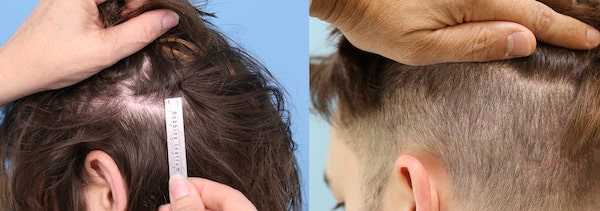Hair Loss to Hide a Scar – How Does it Work?
If a person experiences some type of trauma or accident to the scalp, the result might include the appearance of a scar on the scalp. It is obvious to say that no one wants to have a visible scar on their scalp. Thankfully, there is a chance for the scar to be hidden from view if the patient has a hair transplant.
Curious about how a hair transplant is able to conceal the appearance of a scar? Keep reading to learn how a hair transplant can address a scar on the scalp and the type of results that can be expected from the procedure.

Hair Transplant – What Happens with the Scar Tissue
Once a scar starts to form on the scalp of a person, their hair will not be able to grow naturally in the area of the scar because there are not any hair follicles located in the scar. In general, hair follicles are capsules located under the skin. In addition, the blood vessels that are located under the follicles help them grow. This process is interrupted if a scar forms on skin that is damaged by an accident or trauma as the hair follicles are not able grow back. Keep in mind that scars are composed of collagen that forms to the protect the skin that is under it. In other words, there is normally not any available space for hair follicles in the scar which means a traditional hair transplant is not able to place hair into the follicles that currently exist.
Instead, the surgeon will have to transplant hair grafts still contained in their follicles into the scar. This step allows the hair grafts to begin to take root, so they start to grow again thanks to them coming into contact with the blood vessels. Once the impacted area has healed and the hair follicles have taken hold in the skin to the point they are getting a flow of blood from nearby blood vessels, the hair follicles will begin to grow back.
There is also another treatment option if the scar tissue is raised and thick. In this case, the doctor might recommend that the patient receive corticosteroid injections around the scar, so the surface flattens in the area being treated which helps it gain a more natural appearance.
Hair Transplant to Help Hide a Scar – How it is Performed
The surgeon can perform Follicular Unit Extraction (FUE) hair transplant surgery which means the doctor will remove hair follicles on an individual basis from the donor area on the scalp. The hair follicles are usually taken from the sides or back of the scalp because these areas of the scalp are generally resistant to balding. The individually removed hair follicles are placed into openings that the surgeon creates in the scar tissue.
During the first few days after the surgery, the patient might need some pain medication to help control any pain or discomfort at the start of the recovery period. The patient might also need to take antibiotics in order to reduce the chance of an infection occurring after the surgery. There might also be a need for steroids, or other anti-inflammatory medications, to reduce the swelling that occurs following the procedure.
There is no need to be alarmed or concerned if the transplanted hair begins to fall out after the surgery because this is actually a normal part of the healing process. The hair that was transplanted by the surgeon will start to grow back on its own and then proceed to grow just like the native hair in the scalp.
Hair Transplant to Conceal a Scar – What are the Risks and Complications?
During the beginning of the recovery period, patients need to contact their doctor for advice on how to treat any of the following risks and complications:
- Intense or ongoing pain
- Infection
- Prolonged numbness
- Irritation of the scalp
- Fluid or pus drainage from the area that was treated
- Bleeding from the treated area
- Itching that is unbearable or prolonged
Hair Transplant to Hide a Scar – How to Get Started
Patients who are interested in concealing or reducing the look of a scar with a hair transplant should schedule a consultation appointment with a surgeon who is properly trained and experienced in performing a hair transplant for this purpose. The patient can confirm this fact by asking the surgeon about their medical background, knowledge about the procedure, and their board-certification. The patient can also get a good idea about the type of results provided by the surgeon by reading actual patient reviews and asking to see “before and after” photos of patients treated by the surgeon.
The consultation appointment with the surgeon is the perfect opportunity for the patient to ask any questions they have about the surgery and to ask if it will be possible to gain the desired results. The patient can also decide if they are comfortable with the surgeon and feel that they can trust the surgeon to perform a safe and successful hair transplant procedure.
The doctor will take the time to examine the scar to determine its size and condition in order to develop a treatment plan for the patient. The consultation appointment is also the time that the surgeon will make sure that the person is healthy enough to have the procedure and that the issue with the scar on the scalp can be treated and resolved with a hair transplant.
The patient also needs to perform research on their own so they can make an informed decision about whether or not they want to have a hair transplant to hide the scar on their scalp.